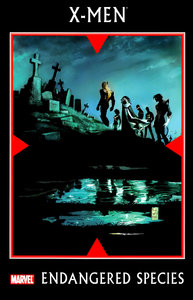 “Sick thing is, it takes a situation like this to make us look death in the face. Really look at it. And that’s the only way you know what life is worth.”
“Sick thing is, it takes a situation like this to make us look death in the face. Really look at it. And that’s the only way you know what life is worth.”
– Wolverine, Endangered Species
Endangered Species is, if you listen to what Marvel puts on their trade dress, the prequel to the wildly successful Messiah Complex storyline, which briefly brought the X-Men back to the forefront of the Marvel U. after a number of years spent in relative mediocrity following Grant Morrison’s much-lauded run on the title. However, despite what’s written on the dustjacket, one could read House of M, the massive crossover event which caused the events still being explored in X-Men today, then proceed straight on to Messiah Complex without missing a beat. Endangered Species is not so much an integral link between the two books, so much as it is a fascinating side-story, and one of the better examinations of Hank McCoy (Beast)’s character that I’ve yet to read.
Despite being an integral part of the X-Men mythos since its inception, Beast has spent surprisingly little time center stage. He’s (almost) always been around as the token smart guy on the team, relaying a constant stream of technobabble complex enough to make Geordi La Forge blush, while scaling walls, smashing heads, and just generally being an insanely useful guy. But seldom have we taken time out (let alone an entire story arc) purely to look at what makes him tick, and just how far he’ll go to accomplish an unsurmountable goal.
The book begins with the perfect recipe for a Shakespearian comedy – the funeral of Matt Landru, one of the thousands of mutants killed when all but a few hundred worldwide lost their powers on “M-Day” – the day Wanda Maximoff (the Scarlet Witch) used her hex powers to put an end to the mutant race. But unlike in Shakespeare, nobody here is laughing, nor will this story end in a wedding. Landru’s funeral (the implication being that it’s only one of many the X-Men have attended) spurs Beast into action, and he begins a globe-trotting quest to scale any mountain, and sink to any low, if it means reversing the effect of Maximoff’s spell, and preventing the imminent extinction of his species.
The story was originally presented as a one-shot, and a series of seventeen 8-page backup stories in other X-books. Very Marvel, but at least it was a momentary excuse for their books to cost $3.99 – which only brings out the fact that they’ve lacked a reason ever since. My personal hatred of Marvel’s business practices aside, though, the format does make this book an interesting read in graphic novel form, because the chapters feel considerably more like chapters in a prose novel here. 8 pages of comics takes much less time to read than a typical chapter in a novel, but they oftentimes impart roughly the same amount of information (unless the author’s feeling particularly expository). However, the fact that these chapters were being released weekly in their original format means that the art duties were handled by a number of individuals, and this is occasionally problematic.
Scott Eaton and Mike Perkins handle the majority of the art, while Mark Bagley, Tom Grummet, and Andrea Divito each fill in on a chapter or two. While a noted effort is taken to homogenize the styles of each artist, the transitions are nonetheless jarring when the artist switches every 8 to 16 pages. That being said, though, the art is quite good throughout the book, and Scott Eaton’s art in particular quite impressed me, especially considering I wasn’t familiar with him going in. A major factor in the different art styles coalescing as well as they do is the superb color work by Raul Trevino and Frank D’armata. Many people tend to downplay the importance of colorists in this digital age, but it’s books like this one that really serve to point out how important they can be.
The book features a large ensemble cast of Marvel’s smartest evil dudes, with everyone from Arnim Zola to Sugar Man making an appearance (and plenty in-between), mostly to turn down Dr. McCoy’s cries for help in saving the mutant race. Help eventually comes from the unlikely (unless you’re a reader, rather than a protagonist, in which case you saw it coming miles away) paws of…well, Beast. But not our beast. Not the lovable smart guy who recited so much poetry while gleefully busting bad guys a new one – rather the evil mad-scientist type who (in a bit of continuity that’s always escaped me) managed to be one of just a few “alternate” characters to make it out of the Age of Apocalypse timeline. Together, Hank and the “Dark Beast” do a bit more globe-trotting, uncovering some particularly nasty secrets of past Marvel history along the way. Ultimately, though, they don’t find any kind of miraculous “cure”. They don’t find a way to reverse a form of magic which has tied itself to the very fabrics of their reality. That’s not what this book is about. What they do find, or at least, what our Beast finds, is peace. Peace enough to bury the dead, and go on living. At least, you know, until the next big crossover-y event.
All in all, Endangered Species is an extremely well-done, if somewhat unnecessary, chapter in the “Messiah” epic that ran through several years worth of X-books. Its much more personal than the rest of the story, and it features a single character that I’ve always felt got short-shrift when it came to these types of things. More than in most other X-books I’ve read, you really get a good look into Hank McCoy’s head in this book, and its not all the serums and obscure poetry references he’s most well-known for. The initial concept of the character was that his personality would belie his brutish exterior, but as both his physical appearance and his personality have evolved over the almost 50 years of his existence, they’ve grown closer together in ways not readily apparent. Inside the Beast lies a truly noble heart, combined with a mind not only sharp enough to win most battles, but also to realize when they are no longer worth fighting.
I’m hoping to eventually look at each of the books in this arc individually, but for anyone who’s curious on the exact order beforehand, the order in which to get this entire arc is House of M, followed by Endangered Species, Messiah Complex, Manifest Destiny, Messiah War, Utopia, Nation X, and Second Coming.

